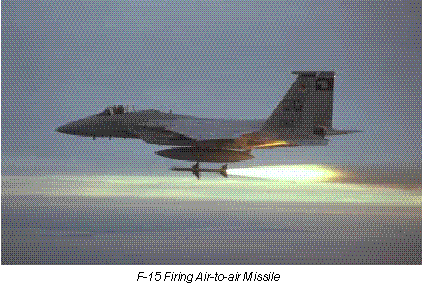
F-15 Firing Air-to-air Missile
EXECUTIVE SUMMARY
* Discusses the Nature of Joint Air Operations
* Provides General Considerations for Command and Control of Joint Air Operations
* Covers Planning for Joint Air Operations
* Discusses Targeting and Tasking for Joint Air Operations
Fundamental principles and doctrine for the command and control (C2) of joint air operations ensure unity of effort for the benefit of the joint force as a whole.
Operational level relationships, policies, and procedures provide the principles and options for command and control (C2) of joint air operations through the designation of a joint force air component commander (JFACC) or use of the joint force commander's (JFC) staff at the unified command level, subordinate unified command level, or joint task force level.
Joint air operations are those air operations performed with air capabilities/forces made available by components in support of the joint force commander's (JFC's) operation or campaign objectives or in support of other components of the Joint force.
The JFC integrates the actions of assigned, attached, and supporting forces into unified area of responsibility (AOR)/ joint operations area (JOA)-wide joint air operations. In order to create synergism and avoid duplication of effort, the JFC synchronizes the actions of assigned, attached, and supporting capabilities/forces in time, space, and purpose.
The JFC develops a concept of operations and organizes forces based on that concept in order to accomplish the assigned mission.
The organization the JFC develops should be sufficiently flexible to meet the planned phases of the contemplated operations and any development that may necessitate a change in the plan. Unity of effort is necessary for effectiveness and efficiency. Centralized planning is essential for controlling and coordinating the efforts of all available forces. Decentralized execution is essential to generate the tempo of operations required and to cope with the uncertainty, disorder, and fluidity of combat.
The JFC may designate a joint force air component commander (JFACC) or directly plan, direct, and control joint air operations.
The JFC will normally designate a JFACC to exploit the capabilities of joint air operations through a cohesive joint air operations plan and a responsive and integrated control system. When a JFACC is not designated, the JFC may plan, direct, and control joint air operations.
The framework and processes for C2 of joint air operations are consistent, although missions vary widely across the range of military operations from war to military operations other than war (MOOTW).
Unity of effort, centralized planning, and decentralized execution are as important in military operations other than war (MOOTW) as in war. Strategies, objectives, centers of gravity, targets, and adversaries apply in MOOTW as well as in war, but may require an expanded perspective to identify them. By taking this into consideration, the JFC can effectively apply the joint doctrine for C2 of joint air operations in myriad, divergent situations.
The air capabilities/forces forces made available for JFACC or JFC stuff planning and tasking are determined by the JFC, in consultation with component commanders, and are based on the assigned objectives and the concept of operations.
Component commanders make air capabilities/forces available to the JFC for tasking to support the joint force as a whole. These capabilities/forces are tasked directly by the JFC or by the JFACC based on the JFC's air apportionment decision. Only the JFC has the authority to reassign, redirect, or reallocate a component's direct support air capabilities/forces. Component capabilities/forces not available for joint air tasking must still comply with the airspace control order (ACO) and Special Instructions (SPINS).

F-15 Firing Air-to-air Missile
JFC will normally designate a JFACC.
The need for a JFACC is based on the JFC's overall mission, concept of operations, the missions and tasks assigned to subordinate commanders, forces available, duration and nature of joint air operations desired, and the degree of unity of command and control of joint air operations required. The authority and command relationships of the JFACC are established by the JFC. These typically include exercising operational control over assigned and attached forces and tactical control over other military capabilities/forces made available for tasking. The responsibilities of the JFACC include, but are not limited to planning, coordinating, allocating, and tasking joint air operations based on the JFC's concept of operations and air apportionment decision.
The responsibilities of the JFACC airspace control authority, and area air defense commander are interrelated and should normally be assigned to one individual
The functions and responsibilities of the JFACC, airspace control authority (ACA), and area air defense commander (AADC) must be integrated in order to unite joint air operations with joint airspace control and joint air defense operations in support of the JFC's campaign. These functions include developing, coordinating, and publishing airspace control procedures, operating the airspace control system, and integrating the joint force air defense effort.
The degree of control needed in the transitional environment of MOOTW may vary.
Depending on the environment, mission, and location throughout the full range of potential military operations, the degree of control may need to be more rigorous and the rules of engagement may need to be more restrictive. This is especially true in a MOOTW environment that can transition quickly from combat to noncombat and back again and often has constraints on the forces, weapons, tactics employed, and the level of violence. Consequently, as a minimum, in MOOTW environments prone to such fluctuations, all air missions, including both fixed- and rotary-wing of all components, must appear on the appropriate air tasking order (ATO) and/or flight plan. In addition, all aircraft must monitor a common frequency and operate on designated identification friend or foe (IFF) modes and codes, which must be appropriately checked prior to mission start. In cases of high density aircraft operations, such as in a properly designated high density airspace control zone or amphibious objective area published on the ACO, aircraft may operate without an ATO mission number. This type of rigorous control is necessary during such MOOTW because the mix of friendly, enemy, and neutral aircraft and mission constraints requires the JFC to strictly control flights in the AOR/JOA (e.g., peace operations). No matter what methods the JFC chooses, they need to be continually evaluated for effectiveness and efficiency as the environment and mission change.
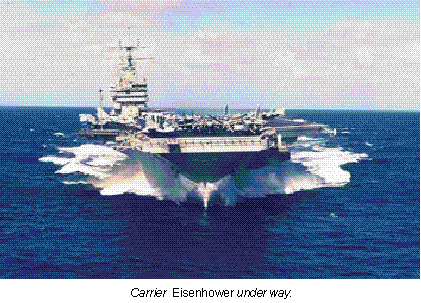
JFACC's operations center will of often be designated a joint air operations center.
The JFACC's joint air operations center (JAOC) is structured to operate as a fully integrated facility and staffed to fulfill all of the JFACC's responsibilities. The two organizations or functions which should be common to all JAOCs are Combat Plans (future joint air operations) and Combat Operations (execution of the daily joint ATO). The role of intelligence is also extremely important and is an integral part of the daily function of Combat Plans and Combat Operations.
The components have ready access to the JFACC and staff through the component liaisons. These liaisons work for their respective component commanders and work with the JFACC and staff.
Senior component liaisons serve as conduits for direct coordination between the JFACC and their respective component commanders. Coordination elements provide liaison elements that work within the JAOC, consisting of specialists who provide component planning and tasking expertise and coordination capabilities. They help integrate and coordinate their component's participation in joint air operations and coordinate and deconflict component direct support air operations with joint air operations. Functional area and mission experts provide the critical and unique expertise in support, plans, and execution functions, as appropriate for the employment scenario.
Assignment of a JFACC ashore, assignment of a seabased JFACC, a JFACC transition (including planned Joint
Extensive planning is necessary when there is transition of JFACC responsibilities.
and unplanned transitions), and attendant transition events must be considered. Other considerations required are for continuous, uninterrupted, and unambiguous guidance; appropriate command, control, communications, computers, and intelligence capabilities; specific procedures for coordinating and executing planned and unplanned shifts of the JFACC; adequate communications; current joint ATO; the JFC's objectives; and the familiarity with the area air defense and airspace control plans.
In some situations, designation of a JFACC is not required.
Designation of a JFACC may not be required when a conflict or situation is of limited duration, scope, and/ or complexity. The JFC would coordinate span of control, unity of effort, staff authority and responsibilities, execution, joint airspace control, joint air defense, supporting operations, the JFC staff organization and manning, and the transition between JFC staff to JFACC.
Planning for Joint air operations begins with understanding the joint force mission. The JFC's strategic appreciation of the political, economic, military, and social forces affecting the AOR/JOA and the articulation of strategic and operational objectives needed to accomplish the mission form the basis for determining components' objectives.
Joint air operations constitute an integral part of the JFC's operation or campaign plan.
The joint air operations plan documents the JFACC's plan for integrating and coordinating joint air operations. The joint air operation plan encompasses operations of joint air capabilities/forces. A selected team of planners and weapon systems experts from each component enables consideration and understanding of all component capabilities/forces.
There are five phases in the air operations planning process:
1. Operational Environmental Research
Operational Environment Research is primarily the intelligence preparation of the battlespace and gathering in-depth knowledge of the operational environment to gain understanding of the theater of operations, the adversary, and friendly forces.
2. Objective Determination
Objective Determination defines and quantifies objectives that will contribute to the accomplishment of the JFC's operation or campaign objectives.
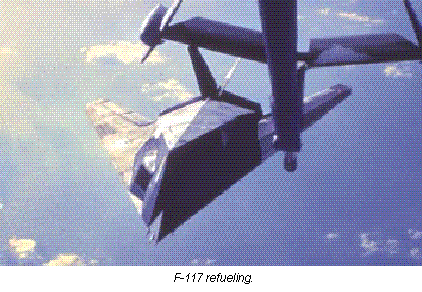
F-117 refueling
3. Strategy Identification
Strategy Identification in a clearly defined air strategy statement states how the JFACC plans to exploit air capabilities/forces to support the JFC's objectives.
4. Center(s) of Gravity Identification
Center(s) of Gravity (COG) Identification is the identification of those adversary COGs which should be attacked to satisfy the JFC's strategic, operational, and tactical objectives and friendly COGs that should be defended.
5. Joint Air Operations Plan Development
Joint Air Operations Plan Development details how joint air operations will support the JFC's operation or campaign plan. During this phase, planners integrate the efforts of joint capabilities/ forces, prioritize objectives and targets while accounting for current and potential threats, and conduct target development/ system analysis. They also phase joint air operations with the JFC's operation or campaign plan, indicating what capabilities/forces will be required to achieve joint air operations objectives. Finally, during this phase, planners will complete a sustainability assessment and delineate the specific procedures for allocating, tasking, and exercising C2 of available air capabilities/forces.
Targeting is the process of selecting targets and matching the appropriate response to them.
Targeting occurs and is performed at all levels of command. An effective and efficient target development process and air tasking cycle is essential for the JFACC/JFC staff to plan and execute joint air operations.
Targeting is a cyclical process.
The targeting cycle begins with objectives and guidance issued by the JFC and includes target development, weaponeering assessment, force application, execution planning/force execution, and combat assessment.
The JFACC/JFC staff develops a joint air operations that accomplishes the objectives directed by the JFC.
Synchronization, integration, deconfliction, allocation of air capabilities/forces, and matching appropriate weapons against target vulnerabilities are essential targeting functions of the JFACC. Components should provide the JFACC with a description of their direct support plan to allow for coordination and deconfliction of targeting efforts between each component and within the JFC staff and agencies.
A joint air tasking cycle is used for the efficient and effective employment of the joint air capabilities/ forces.
The joint air tasking cycle provides a repetitive process for the planning, coordination, allocation, and tasking of joint air missions/sorties and accommodates changing tactical situations or JFC guidance as well as requests for support from other component commanders. The full joint ATO cycle from JFC guidance to the start of ATO execution is dependent on the JFC's procedures, but each ATO period usually covers a 24 hour period. The joint ATO matches specific targets compiled by the JFACC/JFC staff with the capabilities/forces made available to the JFACC for the given joint ATO day.
There are six phases to the joint air tasking order (ATO) cycle:
1. JFC/Component Coordination
Phase 1, JFC/Component Coordination. The JFC consults with his component commanders to assess the results of the warfighting effort. This provides component commanders an opportunity to introduce recommendations, support requirements, and state their ability to support other components. JFC's will normally apportion the air effort by priority or percentage of effort into geographic areas, against mission-type orders, and/or by categories significant for the campaign.
2. Target Development
Phase 2, Target Development. The specific objectives received during phase 1 are used to focus target development. In accordance with JFC's objectives and component targeting requirements, the JFACC/JFC staff will develop the joint air operations plan to employ available joint air capabilities/ forces. The end product is a prioritized list of targets--the Joint Integrated Prioritized Target List.
3. Weaponeering/Allocation
Phase 3, Weaponeering/Allocation. Targeting personnel quantify the expected results of lethal and nonlethal weapons employment against prioritized targets including recommended aimpoints, target identification and description, and other pertinent information. The final prioritized target nominations are then included into the Master Air Attack Plan (MAAP) The resulting MAAP is the employment plan that forms the foundation of the joint ATO. Following the JFC air apportionment decision, the JFACC/JFC staff translates that decision into total number of sorties by aircraft or weapon type available for each operation/task they support.
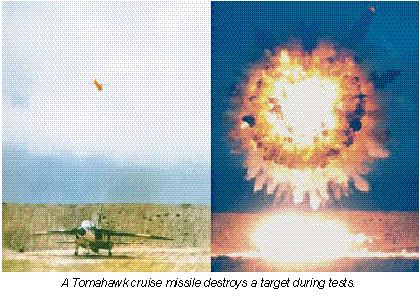
A Tomahawk cruise missile destroys a target during tests.
4. Joint ATO Development
Phase 4, Joint ATO Development. After the MAAP is approved by the JFACC (JFC under the JFC staff option), detailed preparations continue by Combat Plans section on the joint ATO, SPINS, and the ACO. The JAOC reviews each air capable component's allocation decision/Air Allocation Request message and may prepare a sortie allotment message back to the components as required.
5. Force Execution
Phase 5, Force Execution. The JFACC/JFC staff directs the execution and/or deconflicts all capabilities/ forces made available for a given ATO. The JFC may give the JFACC the authority to redirect joint air operations.
Phase 6, Combat Assessment
Phase 6, Combat Assessment. Combat assessment is done at all levels of the joint force and evaluates combat operations effectiveness in achieving command objectives.
The JFACC/JFC staff JFACC/ JFC staff is responsible for planning and activating all validated joint air communications links that support the JFC's mission and allow accomplishment of the JFC directives.
The successful integration of the joint air effort depends on the ability to exchange information via reliable secure communications with the JFC, joint force staff, and component commanders. Planning for all information exchange requirements and procedures must consider emission control requirements and operations security.
Successful use of joint air forces to support the JFC's operation or campaign plan requires unity of effort, centralized planning, and decentralized execution. The JFC normally designates a JFACC to provide C2 of these joint air capabilities/forces. The processes and framework used are consistent across the range of military operations.
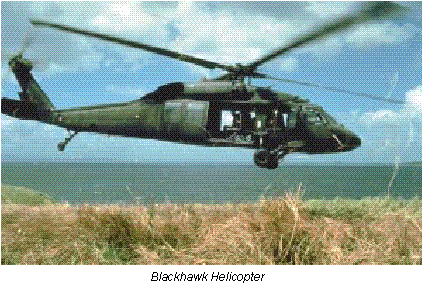
Blackhawk Helicopter